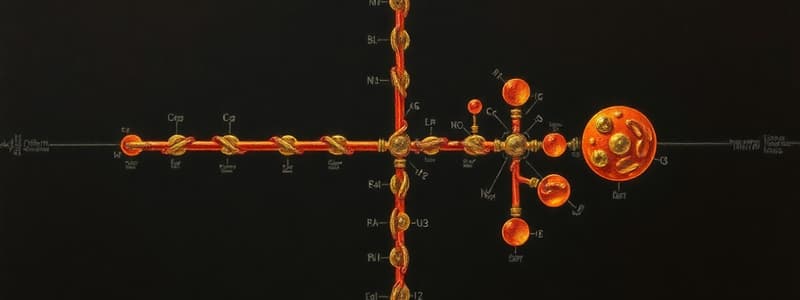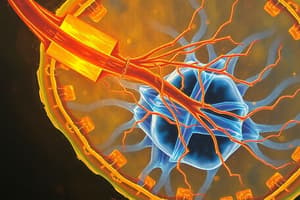Podcast
Questions and Answers
During cellular respiration, what is the primary role of oxygen?
During cellular respiration, what is the primary role of oxygen?
- To act as the final electron acceptor in the electron transport chain. (correct)
- To produce carbon dioxide as a waste product.
- To directly produce ATP through substrate-level phosphorylation.
- To convert glucose into pyruvate during glycolysis.
How does glycolysis contribute to cellular respiration?
How does glycolysis contribute to cellular respiration?
- It converts oxygen into carbon dioxide and water.
- It synthesizes glucose from carbon dioxide and water.
- It directly generates the majority of ATP required by the cell.
- It produces pyruvate molecules that are further processed in the mitochondria. (correct)
Which of the following molecules is NOT directly involved in the electron transport chain?
Which of the following molecules is NOT directly involved in the electron transport chain?
- FADH2
- NADH
- ATP (correct)
- Oxygen
How does substrate-level phosphorylation differ from chemiosmosis in producing ATP?
How does substrate-level phosphorylation differ from chemiosmosis in producing ATP?
If a cell is placed in an anaerobic environment, which of the following processes will be directly inhibited?
If a cell is placed in an anaerobic environment, which of the following processes will be directly inhibited?
What is the primary purpose of fermentation?
What is the primary purpose of fermentation?
Where does the citric acid cycle occur in eukaryotic cells?
Where does the citric acid cycle occur in eukaryotic cells?
What products are generated by the citric acid cycle for each acetyl-CoA molecule that enters?
What products are generated by the citric acid cycle for each acetyl-CoA molecule that enters?
Which of the following statements accurately describes the relationship between cellular respiration and photosynthesis?
Which of the following statements accurately describes the relationship between cellular respiration and photosynthesis?
What is the function of photosynthetic pigments such as chlorophyll?
What is the function of photosynthetic pigments such as chlorophyll?
In the light-dependent reactions of photosynthesis, what is the source of electrons that replenish the electron supply in photosystem II?
In the light-dependent reactions of photosynthesis, what is the source of electrons that replenish the electron supply in photosystem II?
Which of the following is NOT a product of the light-dependent reactions of photosynthesis?
Which of the following is NOT a product of the light-dependent reactions of photosynthesis?
What is the primary function of the Calvin cycle in photosynthesis?
What is the primary function of the Calvin cycle in photosynthesis?
Which enzyme is responsible for the initial carbon fixation step in the Calvin cycle?
Which enzyme is responsible for the initial carbon fixation step in the Calvin cycle?
How do C4 plants minimize photorespiration compared to C3 plants?
How do C4 plants minimize photorespiration compared to C3 plants?
A plant is exposed to high levels of oxygen and low levels of carbon dioxide. Which of the following processes is most likely to occur at an increased rate?
A plant is exposed to high levels of oxygen and low levels of carbon dioxide. Which of the following processes is most likely to occur at an increased rate?
CAM plants minimize water loss by
CAM plants minimize water loss by
Which of the following is the primary energy currency of the cell?
Which of the following is the primary energy currency of the cell?
What is the role of the electromagnetic spectrum in photosynthesis?
What is the role of the electromagnetic spectrum in photosynthesis?
How do methanogens contribute to respiration without oxygen?
How do methanogens contribute to respiration without oxygen?
Flashcards
Cellular Respiration
Cellular Respiration
Harvests energy (ATP) from foods using oxidation (removal of electrons).
Respiration Equation
Respiration Equation
Glucose + Oxygen -> Carbon Dioxide + Water + Energy
Glycolysis
Glycolysis
Splitting of sugar.
Function of Glycolysis
Function of Glycolysis
Signup and view all the flashcards
Location of Glycolysis
Location of Glycolysis
Signup and view all the flashcards
Input of Glycolysis
Input of Glycolysis
Signup and view all the flashcards
Product of Glycolysis
Product of Glycolysis
Signup and view all the flashcards
Pyruvate Oxidation
Pyruvate Oxidation
Signup and view all the flashcards
Aerobic
Aerobic
Signup and view all the flashcards
Anaerobic Environment
Anaerobic Environment
Signup and view all the flashcards
Pyruvate Oxidation
Pyruvate Oxidation
Signup and view all the flashcards
Function of Citric Acid Cycle
Function of Citric Acid Cycle
Signup and view all the flashcards
Location of Citric Acid Cycle
Location of Citric Acid Cycle
Signup and view all the flashcards
Function of ETC
Function of ETC
Signup and view all the flashcards
Location of ETC
Location of ETC
Signup and view all the flashcards
Input of ETC
Input of ETC
Signup and view all the flashcards
Product of ETC
Product of ETC
Signup and view all the flashcards
Chemiosmosis
Chemiosmosis
Signup and view all the flashcards
Organisms vs. Respiration
Organisms vs. Respiration
Signup and view all the flashcards
Energy vs. Respiration
Energy vs. Respiration
Signup and view all the flashcards
Study Notes
Cellular Respiration
- Cells create ATP from organic compounds (foods) through oxidation (removal of electrons)
- The respiration formula is: glucose + oxygen turns into carbon dioxide + water + energy
- Stages include: Glycolysis, Pyruvate oxidation, Citric Acid Cycle / Krebs Cycle, and the Electron Transport Chain
- Molecules needed are ATP, NADH, and FADH2
Glycolysis
- Glycolysis means splitting sugar
- Makes NADH and ATP, and converts glucose into pyruvate
- Results in a net gain of 2 ATP and 2 NADH molecules
- This process occurs in the cytoplasm of the cell
- Needs one molecule of glucose and two ATP molecules as input
- Produces 2 ATP, 2 NADH, and 2 pyruvate molecules per glucose molecule
- Energy conserved as NADH and ATP through substrate-level phosphorylation
- This is an anaerobic process and does not require/use oxygen
- It is also an exergonic process
Pyruvate Oxidation
- Pyruvate molecules made during glycolysis are converted into acetyl CoA in the mitochondrial matrix
- This results in the formation of acetyl CoA
Fate of Pyruvate
- Aerobic conditions need air or free oxygen
- Anaerobic environments lack molecular oxygen
- This process results in the regeneration of NAD+
Citric Acid Cycle / Krebs Cycle
- Generates energy as ATP through oxidation
- Oxidation of acetyl-CoA is derived from carbohydrates, fats, proteins, and alcohol
- Location is the mitochondrial matrix of eukaryotic cells
- Needs 2 Acetyl-CoA, 6 NAD+, 2 FAD, 2 ADP, and 2 Pi as the inputs
- Produces three NADH, one FADH2, one GTP (or ATP), and two CO2 molecules per acetyl-CoA molecule that enters the cycle
- Each glucose completes two cycles
Electron Transport Chain
- Protein complexes transfer electrons between electron donors and acceptors through redox reactions
- Location is on the inner mitochondrial membrane in eukaryotic cells
- Inputs include NADH, FADH2, ADP, and inorganic phosphate (Pi)
- Products are water and ATP
Chemiosmosis
- Chemiosmosis moves ions like protons across a biological membrane
- This creates an electrochemical gradient used to drive ATP synthesis
- ATP synthase is needed
ATP Yield of Respiration
- Required inputs are 2 ATP from glycolysis, and 10 NADH / 2 FADH2 from the electron transport chain
- Products of respiration are 4 ATP (net of 2 ATP) / 2 NADH from glycolysis
- The Kreb’s Cycle creates 2 ATP / 6 NADH / 2 FADH2 / 4 CO2
- The electron transport chain makes a max of 34 ATP
- Total ATP created is 2 (glycolysis) + 2 (Kreb’s Cycle) + 34 (ETC) = 38 ATP (maximum theoretical yield)
Regulation of Respiration
- Glycolysis primarily occurs at the first two steps and the seventh step of three key enzymatic steps
- Pyruvate oxidation / citric acid cycle converts pyruvate into acetyl-CoA
- This process is crucial in cellular respiration
Respiration Without Oxygen
- Anaerobic respiration creates energy without oxygen
Anaerobic Respiration
- Methanogens are anaerobic archaea and produce methane as a product of their energy metabolism
- Sulfur prokaryotes play a crucial role in the sulfur cycle by metabolizing sulfur and its compounds
- Fermentation is a biochemical process that breaks down organic molecules anaerobically
- It produces energy in the form of ATP and organic end products like ethanol, hydrogen gas, or lactic acid
Fermentation
- Ethanol fermentation is a biological process that converts sugars into cellular energy, producing ethanol and carbon dioxide as by-products
- Lactic acid fermentation is a metabolic process where six-carbon sugars are converted into cellular metabolite lactate, which is lactic acid in solution
Introduction to Photosynthesis
Photosynthesis vs cellular respiration
- Photosynthesis occurs in autotrophs like green plants, algae, and some bacteria
- Cellular respiration occurs in all living organisms
Photosynthesis characteristics
- Requires energy (light) and is endothermic,
- Needs sunlight
- It is anabolic
Mitochondria vs Chloroplast
- Mitochondria break down organic molecules to produce ATP through cellular respiration
- Chloroplasts capture light energy and convert it into chemical energy through photosynthesis
Leaf and Chloroplast Structure
- The two structures are: thylakoid, grana, stroma
Pigments
- Pigments include the electromagnetic spectrum, chlorophylls, carotenoids, and photosystems
Electromagnetic Spectrum
- It is the full range of electromagnetic radiation, organized by frequency or wavelength
- Photons are fundamental particles and make up electromagnetic radiation, including light and radio waves
- The absorption spectrum decreases the intensity of radiation at specific wavelengths
Chlorophylls
- Chlorophylls are green pigments found in plants, algae, and cyanobacteria
- Chlorophyll A is the primary pigment responsible for photosynthesis
- Chlorophyll B is an accessory pigment, collecting light energy to pass it on to chlorophyll a
Carotenoids
- Carotenoids are pigments found in plants, algae, and photosynthetic bacteria
- Carotenoids produce vivid yellow, red, and orange colors in nature
- Phycobiliproteins are water-soluble proteins found in cyanobacteria
Stages of Photosynthesis
- Light-dependent reactions occur in thylakoid membranes
- There are two routes for electron flow: cyclic and noncyclic
Cyclic Photophosphorylation
- Photosystem I only creates ATP
Noncyclic Photophosphorylation
- Photosystem II, spanning from cyanobacteria to higher plants, uses light energy to initiate the transfer of electrons from plastocyanin to ferredoxin
- ATP and NADPH act as coenzymes to carry electrons in enzymatic reactions
- The Z diagram shows the Z scheme of light reactions in photosynthesis
- Photosynthetic electron transport generates chemical energy and reducing equivalents in phototrophic organisms
- Chemiosmosis in photosynthesis occurs in the thylakoid membrane of chloroplasts
- Then, protons (H⁺ ions) move across a membrane down their electrochemical gradient, generating ATP through ATP synthase
Light-Independent Reactions/The Calvin Cycle
- Reactions convert carbon dioxide and other compounds into glucose in the stroma of the chloroplast
Carbon Fixation
- Living organisms convert inorganic carbon, primarily carbon dioxide (CO2), into organic compounds
- Rubisco incorporates CO2 into plants during photosynthesis
Reduction
- Reduction occurs with NADPH
Regeneration
- Regeneration occurs with RuBP
Yield
- 3 turns of the cycle = 1 G3P, 2 G3P make glucose
Energy Cycle
- The chloroplast needs light energy, water (H2O), and carbon dioxide (CO2) as inputs
- It produces oxygen gas (O2) as a waste product, and energy-rich molecules such as ATP and NADPH
- Mitochondria need glucose, fatty acids, and pyruvate as inputs
- Mitochondria then produce ATP, and water (H2O)
Photorespiration
- Rubisco “undoes” carbon fixation, reduces yield
- The conditions favoring photorespiration are when Rubisco “undoes” carbon fixation, reducing yield
Types of Respiration
- C3 – only Calvin Cycle
- C4 – spatial separation of Calvin cycle reduces photorespiration
- CAM – temporal separation of Calvin cycle reduces photorespiration
- C4 and CAM examples
Studying That Suits You
Use AI to generate personalized quizzes and flashcards to suit your learning preferences.




